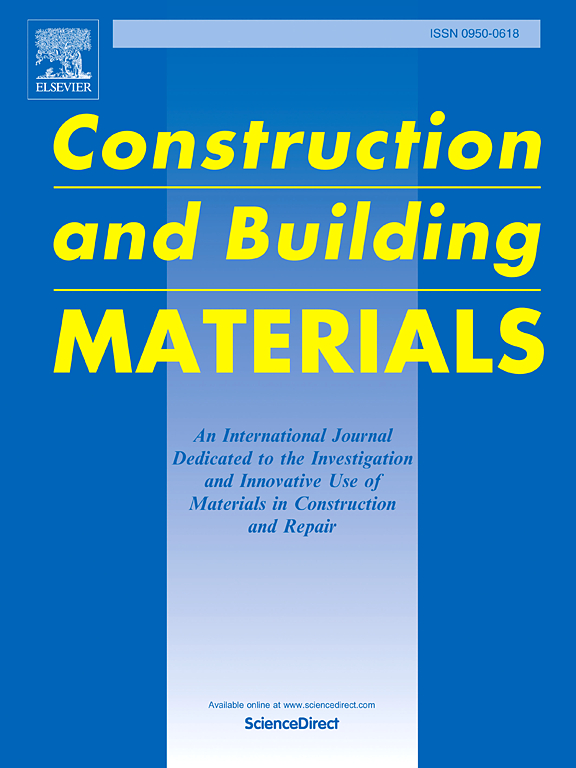Analysis of the stepwise immobilization of phosphorous and fluoride in PG leachate using Fe-doped C-S-H (Fe-C-S-H) prepared with gasification slag and the application of the solidified product
IF 7.4
1区 工程技术
Q1 CONSTRUCTION & BUILDING TECHNOLOGY
引用次数: 0
Abstract
Phosphogypsum leachate contains large amounts of phosphorus and fluoride impurities, resulting in serious pollution of soils and water bodies. This study synthesized calcium silicate hydrate (C-S-H) using SiO₂ and CaO, and Fe-doped calcium silicate hydrate (Fe-C-S-H) using fine coal gasification slag (FCGS) and CaO, both employed to immobilize phosphorus and fluoride impurities in phosphogypsum leachate. In this study, a stepwise precipitation method was applied to control the pH of the leachate system, with F-, HPO42-, and PO43- in the leachate sequentially immobilized. In addition, the influences of C-S-H and Fe-C-S-H prepared with different calcium-to-silicon ratios on the immobilization efficiency of phosphorous and fluoride impurities were explored. Through XRD, FT-IR, zeta potential, SEM-EDS, and molecular dynamics, the mechanisms of phosphorus and fluoride immobilization by these materials were investigated. Furthermore, The immobilized leachate was further utilized as an admixture for phosphogypsum building materials (PBG) to produce enhanced PBG products, thus achieving the recycling utilization of phosphogypsum leachate. Results indicated that at a calcium-to-silicon ratio of 1.2, both C-S-H and Fe-C-S-H achieved optimal rates of immobilization for phosphorus and fluoride, with residual ion concentrations meeting Class V water discharge standards specified in Environmental Quality Standards for Surface Water (GB 3838–2002). In addition, F-, HPO42- and PO43- in the phosphogypsum leachate spontaneously adsorbed onto the (001) crystal planes of C-S-H and Fe-C-S-H. PBG specimens incorporating the immobilized phosphogypsum leachate exhibited a 23.47 %–38.22 % increase in compressive strength. This study not only introduces a novel approach for FCGS utilization but also establishes an innovative method for immobilizing phosphorus and fluoride impurities in phosphogypsum leachate, thus promoting the circular utilization of phosphogypsum waste.
气化渣制备的掺铁C-S-H (Fe-C-S-H)逐步固定化PG渗滤液中的磷、氟及其固化产物的应用分析
磷石膏渗滤液中含有大量的磷和氟杂质,对土壤和水体造成严重污染。本研究以sio2和CaO为原料合成水合硅酸钙(C-S-H),以细煤气化渣(FCGS)和CaO为原料合成掺铁水合硅酸钙(Fe-C-S-H),用于固定磷石膏渗滤液中的磷和氟杂质。本研究采用逐级沉淀法控制渗滤液系统pH,依次固定渗滤液中的F-、HPO42-和PO43-。此外,还探讨了不同钙硅比制备的C-S-H和Fe-C-S-H对磷和氟杂质固定化效率的影响。通过XRD、FT-IR、zeta电位、SEM-EDS和分子动力学等手段,研究了这些材料对磷和氟的固定化机理。进一步将固定化渗滤液作为磷石膏建筑材料(PBG)的外加剂,生产增强型PBG产品,实现磷石膏渗滤液的循环利用。结果表明,在钙硅比为1.2时,C-S-H和Fe-C-S-H对磷和氟的固定率均达到最佳,剩余离子浓度达到《地表水环境质量标准》(GB 3838-2002)中V类水排放标准。此外,磷石膏渗滤液中的F-、HPO42-和PO43-自发吸附在C-S-H和Fe-C-S-H的(001)晶面上。含固定化磷石膏渗滤液的PBG试样抗压强度提高23.47 % -38.22 %。本研究不仅介绍了一种新的FCGS利用途径,而且建立了一种创新的固定磷石膏渗滤液中磷和氟杂质的方法,从而促进了磷石膏废物的循环利用。
本文章由计算机程序翻译,如有差异,请以英文原文为准。
求助全文
约1分钟内获得全文
求助全文
来源期刊

Construction and Building Materials
工程技术-材料科学:综合
CiteScore
13.80
自引率
21.60%
发文量
3632
审稿时长
82 days
期刊介绍:
Construction and Building Materials offers an international platform for sharing innovative and original research and development in the realm of construction and building materials, along with their practical applications in new projects and repair practices. The journal publishes a diverse array of pioneering research and application papers, detailing laboratory investigations and, to a limited extent, numerical analyses or reports on full-scale projects. Multi-part papers are discouraged.
Additionally, Construction and Building Materials features comprehensive case studies and insightful review articles that contribute to new insights in the field. Our focus is on papers related to construction materials, excluding those on structural engineering, geotechnics, and unbound highway layers. Covered materials and technologies encompass cement, concrete reinforcement, bricks and mortars, additives, corrosion technology, ceramics, timber, steel, polymers, glass fibers, recycled materials, bamboo, rammed earth, non-conventional building materials, bituminous materials, and applications in railway materials.
 求助内容:
求助内容: 应助结果提醒方式:
应助结果提醒方式:


